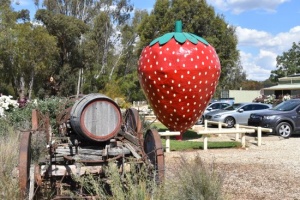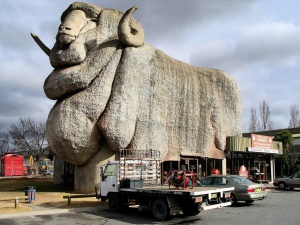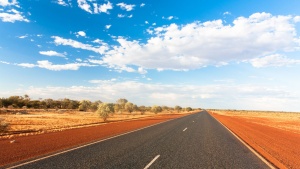Road Tripping
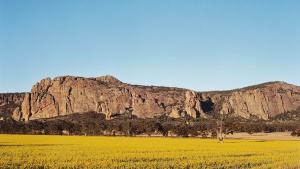 Australian road users have little to break the monotony on long-haul trips other than counting roadkill and gawking at endless open spaces soon relegated to ‘just more scenery’. School holidays meant one thing, a seven-hour drive to Melbourne. After “eye-spy with my little eye”, a sing-along, and counting aloud markers bearing “miles to Melbourne” until Mum begged for “a little shoosh.” All that was left was to sit in silence looking/waiting/hoping for signs of progress. First, Mt Arapiles and Mitre Rock on the left, Grampians on the right, stop at Sister Rocks for home-made sandwiches and Kia-Ora 50/50 cordial. Then, Ararat with the mental asylum where I was told I was going to be left – for good. Early afternoon drew a lengthy stop at Great Western Hotel where Dad whet his whistle in the front bar, Mum sipped shandy in the lady’s lounge, a frosted glass of raspberry lemonade was brought to the car for my brother and me. Back on the road it was through Anthony’s Cutting, named after me I was convinced, next stop apples at Bacchus Marsh. Then miles of old bluestone fences built by real convicts, a sign our destination was one hour away. At last, traffic lights. We arrived at Melbourne’s outer suburb of Deer Park with smog belching factories. Finally, the Big Smoke.
Australian road users have little to break the monotony on long-haul trips other than counting roadkill and gawking at endless open spaces soon relegated to ‘just more scenery’. School holidays meant one thing, a seven-hour drive to Melbourne. After “eye-spy with my little eye”, a sing-along, and counting aloud markers bearing “miles to Melbourne” until Mum begged for “a little shoosh.” All that was left was to sit in silence looking/waiting/hoping for signs of progress. First, Mt Arapiles and Mitre Rock on the left, Grampians on the right, stop at Sister Rocks for home-made sandwiches and Kia-Ora 50/50 cordial. Then, Ararat with the mental asylum where I was told I was going to be left – for good. Early afternoon drew a lengthy stop at Great Western Hotel where Dad whet his whistle in the front bar, Mum sipped shandy in the lady’s lounge, a frosted glass of raspberry lemonade was brought to the car for my brother and me. Back on the road it was through Anthony’s Cutting, named after me I was convinced, next stop apples at Bacchus Marsh. Then miles of old bluestone fences built by real convicts, a sign our destination was one hour away. At last, traffic lights. We arrived at Melbourne’s outer suburb of Deer Park with smog belching factories. Finally, the Big Smoke.
According to the atlas Australia boasts many things that are great, the Great Sandy Desert, the Great Australian Bight, the Great Barrier Reef, the Great Dividing Range, the highway, and township Great Western. Dorothea Mackellar tells us she loves a sunburnt country, a land of sweeping plains, of rugged mountain ranges, of droughts and flooding rains. Australia is girt by sea; we stand and sing allegiance. Donald Horne wrote we are a lucky country. Makes you wonder why we never called things big. We have the world’s biggest single rock; we call it a monolith but never the Big Rock. Initially it was Ayers Rock until cultural sensibilities and social responsibility renamed it Uluru to rightly honour traditional owners. Broken Hill Propriety (BHP), who have shown no such sensibility or responsibility, took land, mined it, plundered its wealth, and became colloquially known as ‘The Big Australian’. This underpinned a late rush to claim Australia as the land of all things big, despite its enshrined, reverential adherence yet cultural antithesis to, ‘the little Aussie battler’.
Christmas Comes Early for Coffs Harbour
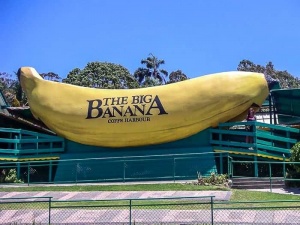 The Australian road trip changed forever in 1964. It was the year The Beatles went number one on the pop charts with I Want to Hold Your Hand, and Australia got its first major roadside attraction. Launched in Coffs Harbour, New South Wales, the brainchild of local banana grower John Landy, it was conceived to stop traffic at his roadside stall. Landy had heard of a big pineapple in Hawaii and thought something big would stop traffic. With fifteen hundred pounds, some ingenuity from a local engineer design began by choosing the best-looking banana sliced into forty pieces. Construction began in September and two days before Christmas it officially launched. Australia welcomes the Big Banana.
The Australian road trip changed forever in 1964. It was the year The Beatles went number one on the pop charts with I Want to Hold Your Hand, and Australia got its first major roadside attraction. Launched in Coffs Harbour, New South Wales, the brainchild of local banana grower John Landy, it was conceived to stop traffic at his roadside stall. Landy had heard of a big pineapple in Hawaii and thought something big would stop traffic. With fifteen hundred pounds, some ingenuity from a local engineer design began by choosing the best-looking banana sliced into forty pieces. Construction began in September and two days before Christmas it officially launched. Australia welcomes the Big Banana.
An obsession spawned a building frenzy spreading across every state and territory in Australia. Dotted across the country are over one hundred and fifty big things. Queensland leads the way with fifty, New South Wales thirty-eight, Victoria on seventeen. Australian Capital Territory with only one needs to lift its game. At dimensionally eight by four metres, they have The Big Mushroom. Laying claim to having a big thing in no way confers ownership and exclusivity to the title. There are big pineapples, chooks, apples, and as if one is not enough, several big crocodiles. Assorted crustaceans are immortalised glorifying the bounty of the sea along the Australian coastline. It seems unlikely the fate of duplication will befall the Big Paperclip, Big Cornish Miner, or Big Rolling Pin.
Often described as cultural monstrosities, or roadside eyesores, they are equally loved and despised however, there is no doubt they became part of the pop art iconography of the 60s. Critiques of popular art didn’t make it to Coffs Harbour and the banana plantations of Mr Landy. Neither has it dulled the passions of travellers to these unique structures. The debate about whether they are art or absurdity continues to rage.
Cultural Cringe to Cultural Icon
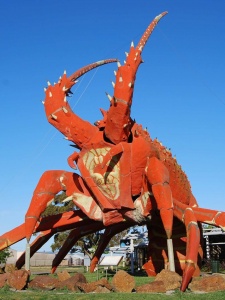 Australian’s have a precarious relationship with their culture. This manifests in unbridled passion and downright adoration bordering on fanaticism for sporting stars, to mild amusement and a belligerent tolerance to any form of artistic success, complete ignorance of scientific achievement, total scepticism and mistrust of political process, economic achievement, even sensible town planning. Australian’s hold absolute contempt for pretenders, upstarts, wankers, and toffs. It’s a big land down under with no room for radical ideology, little tolerance for public demonstrations of anything not concerned with the country’s honour, preferably one fought on some far distant battle front where glorious defeat can be celebrated. A place that made heroes of bushrangers and gangsters, where having fought the good fight the ‘Little Aussie Battler’ is rewarded with mateship and acceptance for coming second. God forbid you should have the effrontery to come first. How bizarre in this egalitarian, multicultural society which gave the world utilitarian wonders such as the Hills Hoist, Victa Motor Mower, Vegemite, Speedos, Tim-Tam biscuits, and the Holden car, should suddenly give rise to a spate of useless, often ugly, roadside monuments to shameless bad taste, crass commercial consumerism, and a preponderance for extravagant feats of ‘do-it-yourself’ engineering.
Australian’s have a precarious relationship with their culture. This manifests in unbridled passion and downright adoration bordering on fanaticism for sporting stars, to mild amusement and a belligerent tolerance to any form of artistic success, complete ignorance of scientific achievement, total scepticism and mistrust of political process, economic achievement, even sensible town planning. Australian’s hold absolute contempt for pretenders, upstarts, wankers, and toffs. It’s a big land down under with no room for radical ideology, little tolerance for public demonstrations of anything not concerned with the country’s honour, preferably one fought on some far distant battle front where glorious defeat can be celebrated. A place that made heroes of bushrangers and gangsters, where having fought the good fight the ‘Little Aussie Battler’ is rewarded with mateship and acceptance for coming second. God forbid you should have the effrontery to come first. How bizarre in this egalitarian, multicultural society which gave the world utilitarian wonders such as the Hills Hoist, Victa Motor Mower, Vegemite, Speedos, Tim-Tam biscuits, and the Holden car, should suddenly give rise to a spate of useless, often ugly, roadside monuments to shameless bad taste, crass commercial consumerism, and a preponderance for extravagant feats of ‘do-it-yourself’ engineering.
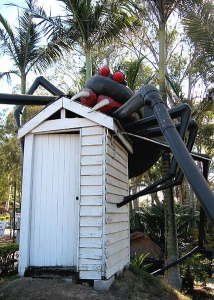 Taste can refer to laws or rules, or social values, it can even be ‘timeless’. The quest for taste found its footing when lone artisans, alienated from society, sought to gate crash high society. There is no research available to explain what motivated structures such as the Big Poo in Kiama, The Big Spanner in Sapphire, or The Big Slide Rule gracing the University of Tasmania, although rational deduction may have more to do with economic ascendancy than gate crashing high society. For the point of understanding taste in relation to the big objects of the Australian highways and byways, look no further than ‘popular’ taste. Remember in 1964 the song of the year featured a simple three chord musical structure, and less challenging lyrics by John Lennon and Paul McCartney of The Beatles. Tasteless pop surely, but a guaranteed sing-along favourite on long tedious family road trips to stall boredom where nothing could bring greater relief to the Australian nuclear family in their four-door family sedan on a blistering hot day, than turning a corner and see The Big Prawn hovering over a wayside stop, or The Big Redback Spider presiding over an Aussie outdoor dunnie. Nothing but sheer relief.
Taste can refer to laws or rules, or social values, it can even be ‘timeless’. The quest for taste found its footing when lone artisans, alienated from society, sought to gate crash high society. There is no research available to explain what motivated structures such as the Big Poo in Kiama, The Big Spanner in Sapphire, or The Big Slide Rule gracing the University of Tasmania, although rational deduction may have more to do with economic ascendancy than gate crashing high society. For the point of understanding taste in relation to the big objects of the Australian highways and byways, look no further than ‘popular’ taste. Remember in 1964 the song of the year featured a simple three chord musical structure, and less challenging lyrics by John Lennon and Paul McCartney of The Beatles. Tasteless pop surely, but a guaranteed sing-along favourite on long tedious family road trips to stall boredom where nothing could bring greater relief to the Australian nuclear family in their four-door family sedan on a blistering hot day, than turning a corner and see The Big Prawn hovering over a wayside stop, or The Big Redback Spider presiding over an Aussie outdoor dunnie. Nothing but sheer relief.
Landmark structures and monuments have always caused concern and debate. Once built, a monument claims its space and cannot be erased from view or memory. It becomes a landmark, and an identifier of place and distance. It gathers people together who can simultaneously view it from a distance, or from the object itself. As a landmark it provides an outward view of terrain, a map of being here, not out there. These monuments at ground level also constitute a “little world” of commerce, postcards, souvenirs, nick-knacks, t-shirts, and very often local produce, and an eatery. The roadside monument becomes a symbol of comfort, relaxation, and pleasure. It becomes an industry within itself, self-sustaining, and re-generative. The monument gathers an iconic value attracting people eager to be photographed with the icon. It validates, is proof of life. It provides how to engage in shared meaning with other humans, “yes, I have been there too, look here I am at The Big Hay Bales.” “If you haven’t been, you must go to The Big Milkshake, it’s a must see.”
Kitsch Turns to Objects of Desire
One of the salient features of kitsch is being univocal, unambiguous, and deadly serious. Evidently this statement was made before being aware of Australian big things for one thing can be said of them all, they certainly are not deadly serious. Quite the contrary. Standing seven metres tall is a very bewildered Big Captain Cook, one arm raised frighteningly reminiscent of a Nazi salute, he stands sentinel over the tourist city of Cairns. He has stood tall above the plants on the Captain Cook Highway for almost forty years. Initially the statue was designed for a public bar however, the measurements got mixed up and he turned out bigger than expected. The delightful irony given Australians’ proclivity for beer, either the designer, the builder, or both could well have imbibed far too much amber fluid at any phase from conception to completion, mistaking measurements. No worries stick it out on the road, she’ll be right mate.
The Big Scotsman at five metres tall pipes welcome to Medindie complete with bagpipes and full tartan kilt, seemingly standing on legs suffering from edema. How a man in a skirt wearing an oversize black hat got this far is uncertain. What is universal and unassailable is the underlying pervasive sense of Australian humour. They are a Big Joke, and we are all in on it. Laced with satiric, self-deprecating humour tantalisingly foreign to people from other countries who don’t get how we laugh at ourselves blatantly “take the piss”, making a mockery of ourselves on a grand and public scale. Clearly having been immortalised as a souvenir, the Big Things have transcended kitsch as something to be sneered at and derided, now they have entered the domain of highly acceptable public art.
Pilgrims Seek Succor from Roadside Shrines
 The road beckons travellers for many reasons, adventure, escape, trade, exploration, new beginnings, seeking, searching, running from a past, forging a new beginning. Many times, a marker, or a small shrine to a deity or animistic entity left by the roadside becomes a totem for others to pay homage, or gain courage, in their own life journey. Secret societies have made use of them to pass information, religious outsiders have rallied sect members, some shrines are barely noticeable to an untrained eye, others announce their presence and demand to be seen. This is the heritage of the Big Things that have sprung up across the country. Maybe once the need for rest was serviced by a remote outpost now we have The Big Galah, The Big Gumboot, among others, to clearly identify a weary traveller has reached safe haven. To validate the visit, there is a lovely shop to purchase souvenirs tea spoons, tea towels and aprons to the more fancied and upmarket iconic snow globes, boutique produce and local cuisine, the Australian equivalent to miracle seekers purchasing Lourdes water from the Grotto of St Bernadette. The bitter retail pill is most tourist nick-knacks have been manufactured in Japan, now China. The choice between locally Australian made piquant products indicative of the big thing, or a mass produced and cheaper facsimile is something that must rankle Australian owners, producers and manufactures as they are by-passed based on price rather than chosen for craftsmanship.
The road beckons travellers for many reasons, adventure, escape, trade, exploration, new beginnings, seeking, searching, running from a past, forging a new beginning. Many times, a marker, or a small shrine to a deity or animistic entity left by the roadside becomes a totem for others to pay homage, or gain courage, in their own life journey. Secret societies have made use of them to pass information, religious outsiders have rallied sect members, some shrines are barely noticeable to an untrained eye, others announce their presence and demand to be seen. This is the heritage of the Big Things that have sprung up across the country. Maybe once the need for rest was serviced by a remote outpost now we have The Big Galah, The Big Gumboot, among others, to clearly identify a weary traveller has reached safe haven. To validate the visit, there is a lovely shop to purchase souvenirs tea spoons, tea towels and aprons to the more fancied and upmarket iconic snow globes, boutique produce and local cuisine, the Australian equivalent to miracle seekers purchasing Lourdes water from the Grotto of St Bernadette. The bitter retail pill is most tourist nick-knacks have been manufactured in Japan, now China. The choice between locally Australian made piquant products indicative of the big thing, or a mass produced and cheaper facsimile is something that must rankle Australian owners, producers and manufactures as they are by-passed based on price rather than chosen for craftsmanship.
The real value of these havens is what it does for its local community in terms of ownership and status, employment, and to regional tourism. The value of products to growers and manufacture adds a dollar value as well as a cultural value. Given a choice of going to another set of golden arches, or The Big Barramundi is hardly a contest as to where you would get the happier meal.
A Big Finish
The road trip has changed. The four-door sedan is a rugged four-wheel drive with GPS satellite navigation system, air-conditioning, plus rear DVD in-car entertainment system for the kids. Probably a good thing as they don’t have wonderful sing-along songs nowadays, for which Enya and Bjork must share the blame. The rugged pioneering spirit of adventure, billy tea and damper cooked on an open fire by the roadside, bumpy potholed roads leaving tyres shredded has given way to dual-lane carriageways bypassing small towns. Roadside assistance 24/7 servicing vehicular malfunction, dazzling illuminated service stations like something landed from outer space. Despite this, the fascination with Big Things has not abated. Will it stop? Time will tell. There is one glaring omission from the pantheon of iconic Big Thing structures. The Big Roadside Sign. Stuck way out the back of Woop-Woop a twenty-metre-high pole with pointers plus the number of kilometres to all Big Things located across the country. Nestled next to it, a little gift shop selling a map of Australia, book of stickers to every site, and a Big Roadside Sign snow globe.
For more information on Big Things visit: https://thegodlesstraveller.com/bloody-big-things/




